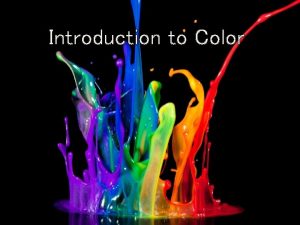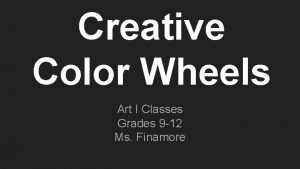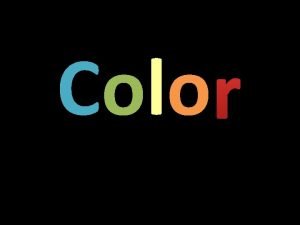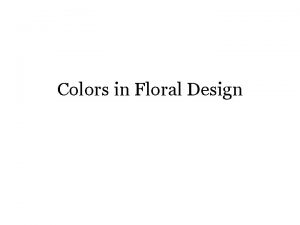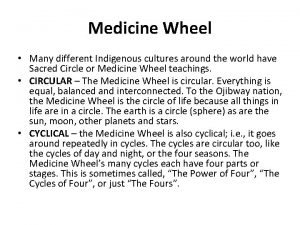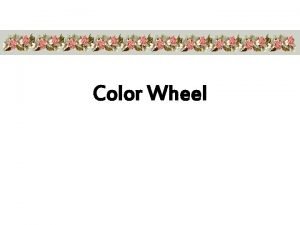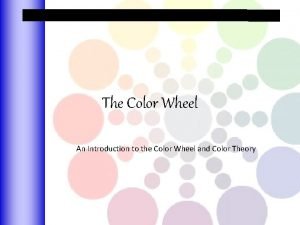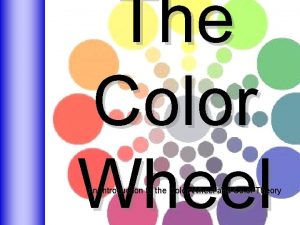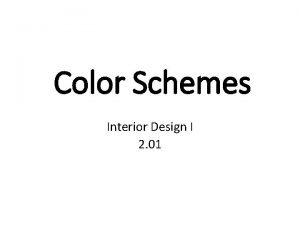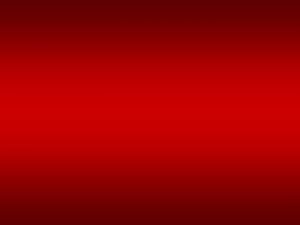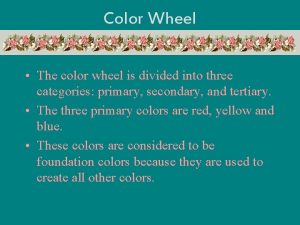Color Wheel Design Project Jennifer Shaiman Primary Colors















- Slides: 15

Color Wheel Design Project Jennifer Shaiman

Primary Colors You’ve probably known that red, yellow, and blue are the primary colors, the base colors from which all other colors are made, since you mixed your paints in kindergarten.

Secondary Colors And you probably remember that when you mixed equal amounts of those colors, you had three new colors to paint with: purple, orange, and green.

Tertiary Colors If you were creative enough to experiment with mixing equal parts of these new secondary colors with one of the primary colors next to them, you may have even created six new colors.

Complementary Colors We can match these colors in various ways that are pleasing to the eye. One way is to match colors directly across from one another on the color wheel. These are complementary colors.

Triad Colors Another way to group colors in a pleasing way is to choose three that are equidistant on the color wheel.

Analogous Colors Complementary colors are pleasing together because of their differences, but analogous colors are pleasing because of their similarity. Analogous colors are located next to each other on the color wheel.

Monochromatic Color You’re probably most familiar with monochromatic color schemes through how they are used in old black & photographs. But any hue can be darkened with black or lightened with white to make a monochromatic scheme of hues (pure color), shades (darkened), and tints (lightened).

Warm Colors Warm colors are those with red and yellow in them. Our eyes are particularly attracted to warm colors, so it is important to use them sparingly to avoid overwhelming a viewer.

Cool Colors Cool colors are those with blue in them. These colors tend to recede from view, especially when there are warm colors present.

Other Ways to Represent Color Up to now, we’ve been discussing the traditional artist’s way of making colors, mixing red, yellow, and blue, but that’s not the only way to make colors. To understand the others, we first need to understand how the eye sees color when we look at an object.

Seeing Color in the World When we look at an object in the real world, what we see is the light that bounces off of it. So while every object is exposed to red, yellow, and blue light, an object appears yellow because it is absorbing the blue and red light.

CMYK When we look at a printed image, the same principles apply: we see the light that isn’t absorbed by the ink on the page. But, in printing, unlike in life, we have a limited number of colored inks to work with. But combining cyan, yellow, magenta, and a key color (black) produces thousands of colors!

Seeing Color on the Screen When we look at an object on a screen, however, the light doesn’t bounce off anything—instead it goes straight into our eyes. In this case, red, green, and blue are the primary colors, and we mix red and green to get the appearance of yellow.

Works Consulted Robin Williams’ The Non-Designer’s Design & Type Book Images People looking at computer screen: vtheikki Book: mgsloan
 Color vs hue
Color vs hue Creative color wheel design
Creative color wheel design 3-5 colors next to each other on the color wheel
3-5 colors next to each other on the color wheel Complementary colors examples
Complementary colors examples Colo.r
Colo.r Color subtraction
Color subtraction Analogous colors are ____ each other on the color wheel.
Analogous colors are ____ each other on the color wheel. Yellow magenta and cyan are the ___
Yellow magenta and cyan are the ___ 3 basic colors
3 basic colors Color theory in floral design
Color theory in floral design Indigenous colour wheel
Indigenous colour wheel Medicine wheel colors
Medicine wheel colors Polychromatic color wheel
Polychromatic color wheel Color red meaning
Color red meaning Primary secondary tertiary colors
Primary secondary tertiary colors Achromatic color scheme room
Achromatic color scheme room
